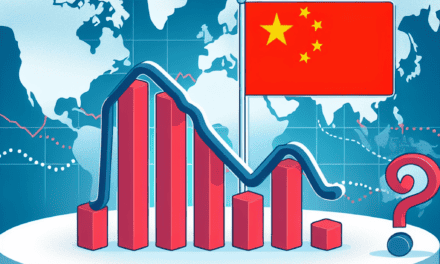“Market Hesitates: Stock Futures Dip as Trump Rally Takes a Breather”
Introduction
Stock futures experienced a decline as the momentum from the Trump rally showed signs of pausing, prompting investors to reassess their positions in the market. This shift comes after a period of significant gains fueled by optimism surrounding potential economic policies and reforms under the Trump administration. The initial surge in stock prices was driven by expectations of tax cuts, deregulation, and increased infrastructure spending, which investors believed would stimulate economic growth. However, as the rally loses steam, market participants are now focusing on the practical implementation of these policies and their potential impact on corporate earnings and economic indicators. This pause in the rally reflects a more cautious approach as investors weigh the uncertainties and challenges that lie ahead, leading to a more volatile and unpredictable market environment.
Impact Of Political Events On Stock Futures
In recent weeks, the financial markets have been closely monitoring the impact of political events on stock futures, particularly in light of the so-called “Trump Rally.” This term refers to the surge in stock prices following the election of Donald Trump as President of the United States, driven by investor optimism about potential tax cuts, deregulation, and infrastructure spending. However, as the initial euphoria begins to wane, stock futures have experienced a dip, prompting investors to reassess their strategies and consider the broader implications of political developments on market performance.
To understand the current state of stock futures, it is essential to consider the factors that initially fueled the Trump Rally. Investors were buoyed by the prospect of pro-business policies that promised to stimulate economic growth. The anticipation of corporate tax reforms, in particular, was seen as a catalyst for increased profitability and higher stock valuations. Additionally, the promise of reduced regulatory burdens was expected to enhance business efficiency and competitiveness, further boosting investor confidence.
However, as the political landscape evolves, the sustainability of these market gains has come into question. One significant factor contributing to the recent dip in stock futures is the uncertainty surrounding the implementation of the proposed policies. While the initial announcements were met with enthusiasm, the complexities of the legislative process have introduced delays and potential modifications to the original plans. This uncertainty has led investors to adopt a more cautious approach, as they weigh the likelihood of policy enactment against the potential risks.
Moreover, geopolitical tensions have also played a role in tempering investor optimism. International relations, particularly those involving trade agreements and diplomatic negotiations, have introduced an additional layer of complexity to the market outlook. The potential for trade disputes or shifts in foreign policy can have far-reaching implications for global markets, influencing investor sentiment and contributing to fluctuations in stock futures.
In addition to these political considerations, economic indicators have also influenced market dynamics. While the U.S. economy has shown signs of strength, with low unemployment rates and steady GDP growth, concerns about inflation and interest rate hikes have emerged. The Federal Reserve’s monetary policy decisions are closely watched by investors, as changes in interest rates can impact borrowing costs, consumer spending, and corporate investment. As a result, any indication of a shift in monetary policy can lead to adjustments in stock futures as investors recalibrate their expectations.
Despite these challenges, it is important to recognize that stock futures are inherently volatile and subject to a wide range of influences. While political events can have a significant impact, they are just one of many factors that investors must consider. Market participants must also take into account economic data, corporate earnings reports, and global market trends when making investment decisions.
In conclusion, the recent dip in stock futures amid a pause in the Trump Rally highlights the complex interplay between political events and market performance. As investors navigate this uncertain landscape, they must remain vigilant and adaptable, considering both the opportunities and risks presented by the evolving political and economic environment. By maintaining a comprehensive understanding of these dynamics, investors can better position themselves to respond to market fluctuations and achieve their financial objectives.
Analyzing The Pause In The Trump Rally
In recent weeks, the financial markets have been closely monitoring the trajectory of stock futures, particularly as they experience a dip amid a pause in what has been termed the “Trump Rally.” This phenomenon, characterized by a significant surge in stock prices following the election of Donald Trump as President of the United States, has captured the attention of investors and analysts alike. However, the current pause in this rally has prompted a deeper analysis of the underlying factors contributing to this shift in market dynamics.
To begin with, it is essential to understand the initial drivers of the Trump Rally. The rally was largely fueled by investor optimism surrounding Trump’s proposed economic policies, which included tax cuts, deregulation, and increased infrastructure spending. These policies were anticipated to stimulate economic growth, boost corporate profits, and ultimately drive stock prices higher. As a result, the markets responded with enthusiasm, leading to a notable increase in stock valuations across various sectors.
However, as the initial euphoria began to wane, investors started to reassess the feasibility and timeline of implementing these policies. This reassessment has been a critical factor contributing to the current pause in the rally. Uncertainty surrounding the legislative process, coupled with political challenges, has raised questions about the likelihood of these policies being enacted in their proposed form. Consequently, this uncertainty has led to a more cautious approach among investors, resulting in a dip in stock futures.
Moreover, the pause in the Trump Rally can also be attributed to external economic factors. Global economic conditions, including fluctuating commodity prices and geopolitical tensions, have played a significant role in shaping investor sentiment. For instance, concerns over trade relations and potential tariffs have introduced an element of unpredictability into the markets, prompting investors to adopt a more risk-averse stance. Additionally, fluctuations in oil prices have had a ripple effect on energy stocks, further contributing to the overall market volatility.
In addition to these factors, the role of monetary policy cannot be overlooked. The Federal Reserve’s stance on interest rates has been a pivotal consideration for investors. As the Fed signals potential rate hikes in response to inflationary pressures, the cost of borrowing is expected to rise. This prospect has led to a recalibration of investment strategies, as higher interest rates could impact corporate earnings and consumer spending. Consequently, this has added another layer of complexity to the market landscape, influencing the current pause in the rally.
Furthermore, it is important to consider the psychological aspect of market behavior. Investor sentiment is often driven by a combination of rational analysis and emotional response. The initial surge in the Trump Rally was, in part, a reflection of heightened optimism and confidence in the new administration’s ability to deliver on its promises. However, as reality sets in and challenges emerge, investor sentiment has become more tempered, leading to a more measured approach to market participation.
In conclusion, the dip in stock futures amid the pause in the Trump Rally is a multifaceted phenomenon influenced by a confluence of factors. From the reassessment of policy implementation to external economic conditions and monetary policy considerations, each element plays a crucial role in shaping market dynamics. As investors navigate this complex landscape, a nuanced understanding of these factors will be essential in making informed decisions and anticipating future market trends.
Factors Contributing To The Dip In Stock Futures
In recent trading sessions, stock futures have experienced a noticeable dip, marking a pause in the robust rally that had been associated with the policies and economic optimism surrounding the Trump administration. This downturn in stock futures can be attributed to a confluence of factors that have collectively influenced investor sentiment and market dynamics. Understanding these factors is crucial for investors and market analysts as they navigate the complexities of the current financial landscape.
One of the primary factors contributing to the dip in stock futures is the growing uncertainty surrounding the implementation of key economic policies promised by the Trump administration. While initial enthusiasm was fueled by expectations of tax cuts, deregulation, and infrastructure spending, delays and political challenges have tempered investor optimism. The legislative process has proven to be more intricate and protracted than initially anticipated, leading to doubts about the timing and scale of these policy measures. Consequently, investors have become more cautious, reassessing their positions in anticipation of potential policy setbacks.
In addition to policy-related uncertainties, geopolitical tensions have also played a significant role in dampening market sentiment. Recent developments on the international stage, including escalating trade disputes and diplomatic strains, have introduced an element of unpredictability into global markets. The imposition of tariffs and retaliatory measures by major economies has raised concerns about the potential for a trade war, which could disrupt global supply chains and adversely impact economic growth. As a result, investors have become more risk-averse, seeking refuge in safer assets and contributing to the decline in stock futures.
Moreover, economic indicators have presented a mixed picture, further complicating the market outlook. While certain sectors have shown resilience, others have exhibited signs of slowing growth. For instance, manufacturing data has been less robust than expected, raising questions about the sustainability of the economic expansion. Additionally, inflationary pressures have begun to surface, prompting speculation about potential interest rate hikes by the Federal Reserve. The prospect of rising borrowing costs has added another layer of complexity to the investment landscape, as higher interest rates could dampen consumer spending and corporate investment.
Furthermore, corporate earnings reports have been a mixed bag, with some companies exceeding expectations while others have fallen short. This variability in earnings performance has introduced additional volatility into the market, as investors reassess the valuations of individual stocks and sectors. The divergence in corporate results underscores the challenges faced by businesses in navigating an evolving economic environment, characterized by shifting consumer preferences and technological disruptions.
In light of these factors, it is evident that the dip in stock futures is not attributable to a single cause but rather a combination of interrelated elements. As investors grapple with these complexities, market volatility is likely to persist in the near term. However, it is important to note that periods of market fluctuation are not uncommon and can present opportunities for astute investors to recalibrate their portfolios.
In conclusion, the recent dip in stock futures amid a pause in the Trump rally can be traced to a myriad of factors, including policy uncertainties, geopolitical tensions, mixed economic indicators, and variable corporate earnings. As the market continues to navigate these challenges, investors are advised to remain vigilant and informed, carefully considering the broader economic context and potential implications for their investment strategies.
Market Reactions To Political Uncertainty
In recent weeks, the financial markets have been closely monitoring the political landscape, particularly the developments surrounding former President Donald Trump. The stock futures have experienced a dip, signaling a pause in the rally that had been associated with Trump’s influence on market sentiment. This shift in market dynamics can be attributed to a confluence of factors, primarily revolving around political uncertainty and its implications for economic policy and investor confidence.
To begin with, the initial rally in the stock market, often referred to as the “Trump Rally,” was largely driven by investor optimism regarding potential policy changes. These included tax cuts, deregulation, and infrastructure spending, which were anticipated to stimulate economic growth. However, as political events unfold, the market’s enthusiasm has been tempered by the realization that such policy implementations may face significant hurdles. The complexities of the legislative process, coupled with the contentious political environment, have introduced a level of unpredictability that investors are finding difficult to navigate.
Moreover, the recent dip in stock futures can also be attributed to broader geopolitical concerns. As the global economy becomes increasingly interconnected, political developments in one region can have far-reaching effects on markets worldwide. For instance, trade tensions and diplomatic relations between major economies have been a source of volatility, influencing investor sentiment and market performance. In this context, the uncertainty surrounding Trump’s political future adds another layer of complexity, as investors weigh the potential impact on international trade agreements and economic partnerships.
In addition to geopolitical factors, domestic economic indicators have also played a role in shaping market reactions. While the U.S. economy has shown signs of resilience, with steady job growth and consumer spending, there are underlying concerns about inflation and interest rates. The Federal Reserve’s monetary policy decisions are closely watched by investors, as they have direct implications for borrowing costs and corporate profitability. Any indication of a shift in the Fed’s stance can lead to fluctuations in stock futures, as market participants adjust their expectations accordingly.
Furthermore, the psychological aspect of market behavior cannot be overlooked. Investor sentiment is often influenced by perceptions of stability and confidence in leadership. The ongoing political uncertainty has created an environment where market participants are more cautious, leading to increased volatility and a more risk-averse approach to investment. This cautious sentiment is reflected in the recent dip in stock futures, as investors seek to mitigate potential risks associated with political developments.
In conclusion, the dip in stock futures amid a pause in the Trump Rally underscores the intricate relationship between political uncertainty and market reactions. As investors navigate this complex landscape, they must consider a multitude of factors, including geopolitical dynamics, domestic economic indicators, and the psychological aspects of market behavior. While the current environment presents challenges, it also offers opportunities for those who can adeptly manage risk and adapt to changing conditions. As the political situation continues to evolve, market participants will remain vigilant, closely monitoring developments and adjusting their strategies to align with the shifting landscape. Ultimately, the interplay between politics and markets will continue to be a defining feature of the financial landscape, shaping investor decisions and market outcomes in the months to come.
Historical Trends In Stock Futures During Political Changes
The stock market has long been a barometer of economic sentiment, often reacting swiftly to political changes and the potential implications they carry for future economic policies. Historically, stock futures have exhibited notable fluctuations during periods of political transition, reflecting investor uncertainty and anticipation of new policy directions. The recent dip in stock futures amid a pause in the Trump rally serves as a pertinent example of this phenomenon, highlighting the intricate relationship between political developments and market dynamics.
To understand the current market behavior, it is essential to examine historical trends in stock futures during previous political changes. Historically, markets have shown a tendency to react to both the anticipation and the aftermath of significant political events, such as elections or changes in administration. For instance, during the 2008 U.S. presidential election, stock futures experienced heightened volatility as investors grappled with the implications of a new administration amid a global financial crisis. Similarly, the 2016 election saw stock futures initially plummet in response to unexpected results, only to recover and rally as investors adjusted their expectations to align with anticipated policy shifts.
The Trump rally, characterized by a significant surge in stock prices following the 2016 election, was largely driven by investor optimism regarding proposed tax cuts, deregulation, and infrastructure spending. However, as with any political rally, the sustainability of such market enthusiasm is contingent upon the actualization of these policies. The recent dip in stock futures suggests a momentary pause as investors reassess the likelihood of these policies being implemented and their potential impact on economic growth.
Moreover, the interplay between political rhetoric and market expectations cannot be understated. Political leaders often make bold promises during campaigns, which can lead to initial market exuberance. However, the subsequent reality of policy-making, which involves negotiation and compromise, can temper investor expectations. This dynamic is evident in the current market environment, where initial optimism has given way to a more cautious outlook as investors await concrete policy actions.
In addition to domestic political changes, global political developments also play a crucial role in shaping stock futures. Geopolitical tensions, trade negotiations, and international alliances can all influence investor sentiment and market movements. For example, the ongoing trade negotiations between the United States and China have been a significant source of market volatility, with stock futures often reacting to the ebb and flow of these discussions.
Furthermore, it is important to consider the role of economic indicators and corporate earnings in influencing stock futures during political transitions. While political changes can set the stage for market movements, underlying economic fundamentals ultimately drive long-term trends. Investors closely monitor indicators such as GDP growth, employment rates, and corporate earnings reports to gauge the health of the economy and adjust their market positions accordingly.
In conclusion, the dip in stock futures amid a pause in the Trump rally underscores the complex interplay between political changes and market dynamics. Historical trends reveal that stock futures are highly sensitive to political transitions, reflecting investor uncertainty and anticipation of new policy directions. As investors navigate this landscape, they must balance political developments with economic fundamentals to make informed decisions. Ultimately, while political changes can create short-term volatility, the resilience of stock futures often hinges on the broader economic context and the realization of anticipated policy measures.
Investor Strategies During Market Volatility
In the ever-evolving landscape of financial markets, investors are constantly seeking strategies to navigate periods of volatility. The recent dip in stock futures, following a pause in the Trump rally, has prompted many to reassess their investment approaches. Understanding the dynamics at play and adopting informed strategies can be crucial for investors aiming to safeguard their portfolios and capitalize on potential opportunities.
To begin with, it is essential to recognize the factors contributing to the current market volatility. The initial surge in stock prices, often referred to as the Trump rally, was largely driven by investor optimism surrounding anticipated policy changes, including tax reforms and deregulation. However, as the rally pauses, uncertainties regarding the implementation and impact of these policies have led to fluctuations in market sentiment. Consequently, stock futures have experienced a dip, reflecting the cautious stance adopted by many investors.
In light of this, diversification emerges as a fundamental strategy for mitigating risk during volatile periods. By spreading investments across various asset classes, sectors, and geographic regions, investors can reduce their exposure to any single market event. This approach not only helps in cushioning the impact of market downturns but also positions investors to benefit from potential upswings in different areas. For instance, while equities may face headwinds, bonds or commodities might offer stability or even growth, thereby balancing the overall portfolio performance.
Moreover, maintaining a long-term perspective is crucial when navigating market volatility. Short-term fluctuations, though unsettling, are often part of the natural ebb and flow of financial markets. Investors who remain focused on their long-term goals and resist the urge to make impulsive decisions based on short-term market movements are more likely to achieve favorable outcomes. This disciplined approach involves regularly reviewing and adjusting investment strategies to align with evolving market conditions while staying committed to the overarching financial objectives.
In addition to diversification and a long-term outlook, investors can also consider employing hedging strategies to protect their portfolios. Hedging involves using financial instruments, such as options or futures contracts, to offset potential losses in other investments. While this approach may not eliminate risk entirely, it can provide a buffer against adverse market movements, thereby enhancing portfolio resilience. However, it is important for investors to thoroughly understand the complexities and costs associated with hedging before incorporating it into their strategies.
Furthermore, staying informed about macroeconomic indicators and geopolitical developments is vital for making informed investment decisions. Economic data releases, central bank policies, and geopolitical events can significantly influence market dynamics. By keeping abreast of these factors, investors can better anticipate potential market shifts and adjust their strategies accordingly. Engaging with financial news, analysis, and expert opinions can provide valuable insights into the broader market context, aiding investors in making well-informed choices.
In conclusion, while the recent dip in stock futures amid a pause in the Trump rally may present challenges, it also underscores the importance of adopting robust investment strategies during periods of market volatility. By embracing diversification, maintaining a long-term perspective, considering hedging options, and staying informed about macroeconomic and geopolitical developments, investors can navigate the complexities of the financial markets with greater confidence. Ultimately, a thoughtful and informed approach can help investors not only weather the storms of volatility but also seize opportunities for growth and success.
Long-term Implications Of A Pause In The Trump Rally
The recent dip in stock futures, marking a pause in the so-called “Trump Rally,” has prompted investors and analysts to reassess the long-term implications of this development. Since the election of Donald Trump, markets have experienced a significant surge, driven by expectations of pro-business policies, tax cuts, and deregulation. However, the current pause raises questions about the sustainability of this rally and its potential impact on long-term market dynamics.
To begin with, it is essential to understand the factors contributing to the initial rally. The anticipation of corporate tax reforms and infrastructure spending fueled optimism among investors, leading to increased market valuations. Additionally, the promise of deregulation in sectors such as finance and energy further bolstered confidence. However, as the initial excitement begins to wane, market participants are now focusing on the feasibility and timing of these policy implementations. The uncertainty surrounding these factors has contributed to the recent dip in stock futures.
Moreover, the pause in the rally may also reflect broader economic concerns. While the U.S. economy has shown signs of recovery, with steady job growth and rising consumer confidence, there are underlying issues that could affect long-term market performance. For instance, the potential for rising interest rates poses a challenge, as it could increase borrowing costs for businesses and consumers alike. Additionally, geopolitical tensions and trade uncertainties add layers of complexity to the economic landscape, further influencing investor sentiment.
In light of these considerations, it is crucial to examine the potential long-term implications of a pause in the Trump Rally. One possible outcome is a shift in investor focus from short-term gains to more sustainable growth strategies. As the initial euphoria subsides, market participants may prioritize companies with strong fundamentals and robust business models over those merely benefiting from policy expectations. This shift could lead to a more balanced and resilient market environment, where long-term value creation takes precedence over speculative gains.
Furthermore, the pause may encourage a more cautious approach to risk management. Investors, having experienced the volatility associated with policy-driven market movements, might seek to diversify their portfolios to mitigate potential downturns. This could result in increased interest in alternative asset classes, such as bonds, real estate, or commodities, as a means of hedging against market fluctuations. Consequently, a more diversified investment landscape could emerge, offering greater stability and reduced vulnerability to external shocks.
Additionally, the pause in the rally provides an opportunity for policymakers to reassess their strategies. The initial market response to Trump’s election highlighted the importance of clear and consistent policy communication. As such, a more measured approach to policy announcements and implementations could foster greater confidence among investors, reducing market volatility and promoting sustainable growth.
In conclusion, while the recent dip in stock futures signals a pause in the Trump Rally, it also presents an opportunity for reflection and recalibration. By focusing on sustainable growth strategies, diversifying investment portfolios, and fostering clear policy communication, market participants and policymakers alike can navigate the complexities of the current economic landscape. Ultimately, these efforts could lead to a more stable and resilient market environment, better equipped to withstand future challenges and uncertainties.
Q&A
1. **What caused the dip in stock futures?**
– The dip in stock futures was caused by a pause in the rally that had been driven by optimism surrounding policies expected from the Trump administration.
2. **Which sectors were most affected by the dip?**
– Financials, industrials, and materials sectors, which had previously seen gains due to anticipated infrastructure spending and deregulation, were most affected by the dip.
3. **How did the market react to the pause in the Trump rally?**
– The market showed signs of uncertainty and caution, with investors reassessing the sustainability of the rally and the timeline for policy implementation.
4. **What external factors contributed to the market’s performance?**
– External factors included global economic data, Federal Reserve interest rate decisions, and geopolitical tensions, which all played a role in influencing market sentiment.
5. **Were there any notable earnings reports during this period?**
– Yes, several companies reported earnings that either exceeded or fell short of expectations, impacting individual stock performances and contributing to overall market volatility.
6. **How did international markets respond to the dip in U.S. stock futures?**
– International markets experienced mixed reactions, with some regions seeing declines due to concerns over U.S. policy impacts, while others remained stable or saw gains due to local factors.
7. **What are analysts predicting for the future of the market?**
– Analysts are divided, with some predicting a continued correction if policy expectations are not met, while others believe the market will stabilize and resume growth as policies are clarified and implemented.
Conclusion
The dip in stock futures amid a pause in the Trump rally suggests a momentary reassessment by investors of the market’s recent upward momentum. This pause may reflect uncertainties or profit-taking after a period of significant gains driven by policy expectations and economic optimism. The market’s reaction indicates a cautious approach as investors weigh potential risks and rewards in the evolving political and economic landscape. Overall, this development underscores the inherent volatility and sensitivity of financial markets to political and economic signals.





